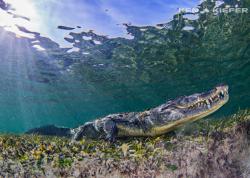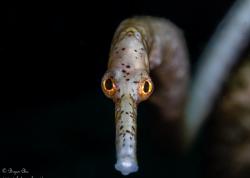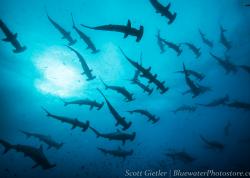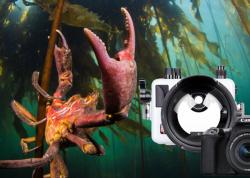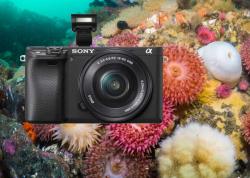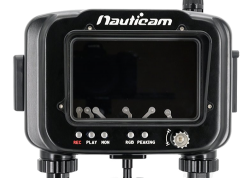Heaven is a Place on Earth: Diving Mauritius
“Mauritius was made first and then heaven; and heaven was copied after Mauritius” – Mark Twain (1896).
As divers, we all dream of exploring that pristine tropical island as far from any other landmass as possible. We dream of white sand beaches, turquois water, mountainous jungles, or strange and wonderful creatures lurking in unexplored places. Well, that dream is a place on Earth, and that place is Mauritius. Located approximately 1000 km (600 miles) east of Madagascar, Mauritius is one of the most remote islands in the Indian Ocean. As the home of the now extinct Dodo, Mauritius is a remnant of the lost (and newly found) continent of Mauritia. Its remote location resulted in the evolution of a unique diversity of endemic flora and fauna that translates to some exceptional diving and hiking.
Diving Overview
Although Mauritius is often overlooked by divers who visit other Indian Ocean locales, such as Seychelles or the Maldives, the diving can be quite good. Overall, Mauritius is a macro-lover’s paradise with some big animal sprinkled in. Frequent cyclones and some overfishing can make the reefs seem a little barren at a first glance when compared to other Indian Ocean destinations. However, the highlights of these reefs are the small stuff, and in every crevice or coral overhang there is something amazing waiting to be discovered.
As one might expect in the middle of the Indian Ocean, the diversity of the reefs is excellent. In one dive you can expect to see peacock flounder, endemic angelfish and butterfly fish, parrotfish, nudibranchs, many species of morays, mantis shrimp, striped eel catfish, lionfish, marlin, turtles, stingrays, octopus, scorpionfish, trevally, gray reef sharks, and 200 species of coral! The hard and soft corals in Mauritius are unique in their shapes and colors. Reefs seem to be speckled with pastel pinks, purples, blues, and greens resembling an Easter-time pallet of color. There are many dive sites to choose from, each offering their own set of unique fauna.
The Best Diving
If you are in Mauritius to dive, then choosing where on the island to go is fairly easy – the North! Diving in the north of the country gives you the best access to its outlying islands, shore-side reef dives, resorts, and the most tourist-friendly part of the country. There is also some good advanced drift diving on the east side of the island and ok diving in Flic en Flac in the west. The south, however, is more exposed to the elements of the Indian Ocean and has poor diving conditions. Learn more about the best diving in Africa here.
Coin de Mire and the Djabeda Wreck Dive
Coin de Mire is a small, peculiar looking island lying 8 km to the north of Mauritius with what many consider to be the best diving in Mauritius. Dives often feature wall and wreck diving with spectacular visibility (50m/200ft on a great day), as well as chances to see large pelagics such as marlin. Its unique geology makes for some interesting underwater canyons and crevices that can be quite fun to swim through.
Perhaps the highlight of all dives at Coin de Mire is the Djabeda wreck dive. The wreck is a 144ft/44m long Japanese fishing vessel sitting perfectly upright at a depth of approximately 100ft/30m. Completely covered in beautiful pink soft coral, the wreck attracts perhaps the largest concentration of fish life on the north side of the island. Octopus, scorpionfish, stonefish, lionfish, and many reef fish are common here. Less common are barracuda, dolphins, and sting rays.
Grand-Baie and Trou-aux-Biches
The highest concentration of dive operations on the islands are situated in the northwest towns of Grand-Baie and Trou-aux-Biches for good reason. Grand-Baie’s proximity to Mauritius’s outlying northern islands as well as amazing diving just outside the bay make it the perfect place to start most dive trips. The diving outside the bay and in neighboring Trou-aux-Biches is where all the best macro critter diving is. Reefs are relatively flat and shallow with short corals that have taken a bit of a beating from cyclones. However, these flat reefs provide just enough protection for vast arrays of small reef fish and small invertebrates to find a home. Just a couple dives here will be enough to come back with a diverse portfolio of macro photos.
The photographic highlights here are the multiple species of morays, very curious and frequent peacock mantis shrimp, and schools of small striped eel catfish. The striped eel catfish can be particularly fun to photograph as they tend to hide under coral heads and allow photographers to get very close to photograph them. Although visibility is not quite as good here as the outlying islands, it is still very good and can reach up to 30m/100ft+ on a good day.
Swimming with Dolphins (Tamarin Bay)
Although there are no trips to dive with dolphins, many tour operators offer morning snorkeling trips with wild spinner dolphins. These tours depart daily at approximately 8-9 am from Tamarin in the southwest of the island and follow the dolphin’s daily feeding path north along the coast to Flic en Flac. Boats will follow the dolphins and drop you in ahead of their path. The dolphins then zip by, and you have a few seconds to take as many photos as possible. The whole process can seem a little stressful to snorkelers as well as dolphins as it can become quite crowded by boats. Personally, I have mixed feeling about the practice, so go at your own discretion. That being said, every now and then a curious dolphin might take interest in you and the experience can become the highlight of your trip.
The Shark Pit
There is one place on the island where sharks are seen regularly – the Shark Pit. The shark pit is located at Flat Island, one of the farthest of Mauritius’s northern outlying islands. Trips are infrequent as it can be expensive, long, and difficult to get to. Recommended only for advanced divers, strong currents and rough seas are common. Bull sharks, gray reef sharks, and silvertip reef sharks are common. Most trips leave from Grand-Baie in the North.
Belle Mare
Belle Mare is the best diving on the east side of the island. It is often drift diving geared to more advanced divers. Pelagics and sharks are the highlights here.
Dive Operators and Prices
There are plenty of dive operators to choose from. Most are very professional and well organized. You can rent any gear you need at any of these shops and most will give a discount for bringing your own. Most operators will be happy to accommodate for photographers. Some organize photography dives whereas others will try to make small groups for you. Diving is like in other tropical places – usually a group of two to seven divers will be led by one or two dive masters. Most shops are good at accommodating for English, French, and German speakers.
Diving is all done from a boat. The immediate shore around the island is generally sandy lagoon, so a boat is needed to motor out to reefs. For local dives, the price can range from $30 USD to $40 USD (1000-1500 Mauritian rupees) per dive. Dives to the outer islands can be quite a bit more.
When to Go
Mauritius is a year-round destination. The Mauritian winter (May to October) is the most ideal for topside activities. The weather is generally cooler, drier, and windier. The Mauritian summer (November to April) is a little rainier, more humid, and hot. Overall topside temperatures differ only slightly, reaching an average of 26 C (79 F) in the summer and 21 C (70 F) in the winter.
There is no true rainy and dry season, as the seasons are very similar. There is, however, a cyclone season from January to March. As Mauritius is a small island, cyclones often miss the country. Thus, it is completely unpredictable whether a cyclone will actually hit – even a few days before. Otherwise summer weather is quite calm.
Diving Conditions
Ironically, summer (November - April) is the best time to dive in Mauritius. The visibility is usually great and the warm water brings a higher diversity of sea life. Winter wind can also make diving conditions less favorable. In order to avoid cyclone season, we recommend diving in Mauritius from October to December and March to April. That being said, the weather at a given time of year likely won’t affect your dive trip.
From November to April, water temperature can be as high as 30 C (86 F) and from March to October, water temperature can drop to as low as 21 C (70 F). Generally, a 3 mm wetsuit is recommended, and possibly a 5 mm for winter months.

Rain
Although summer is technically the rainy season (especially in January and February), rain is usually not an issue. When it does rain in Mauritius, it happens in short bursts and becomes sunny immediately after. Often it can be raining on one side of the island and completely dry in the other. Always be prepared for rain, but don’t expect it to ruin a vacation.
A word of advice: the driest, sunniest part of the island is Grand-Baie. For whatever reason, clouds always seem to avoid that northwest corner, and rain can be infrequent even during rainy season.
Topside Activities
Beaches and Watersports
People come to Mauritius for the beaches. With arguably some of the best beaches in the world, it’s hard to imagine a more perfect place to swim and relax in the sun. The north, west, and east of the island are calm and ideal for swimming, but the south can have a little too much surf (though not any less beautiful). The prettiest beaches are in the southwest surrounding Le Morne Brabant and in the northwest by Grand-Baie. My personal favorites are Mon Choisy, Bain Boeuf, and La Cuvette. The most beautiful water on the island, and perhaps the whole Indian Ocean, is the water in Grand-Baie. There are many days where you can’t tell where the water ends and the sky begins.
The public legally has access to the whole Mauritian coastline, and public beaches are very good. Resorts, however, are a good way to get some exclusivity. They also offer a variety of water sports like banana boats, sailing, stand-up paddle boarding, kayaking, fishing, kite surfing, and more.
Hiking
Hiking is an often overlooked activity in Mauritius. Most people fly in, plop themselves on a beach bed, and fly out. Don’t! The hiking in Mauritius is some of the best in the Indo-Pacific. The island is blessed with many small peaks that make excellent day hikes. Most range around 700 to 800 meters (2200 to 2600 feet) high. The jungles of Mauritius are inundated rare and unusual plants and animals that cannot be seen elsewhere. For example, the Mauritius flying fox, a large species of fruit bat, is the only native mammal to the island and can often be seen flying in the forest canopies in large groups. If you are lucky enough, you might be able to spot a Mauritius ornate day gecko – a colorful but rare gecko also native to the island.
The two most popular hikes are Le Pouce (the thumb) and Le Morne Brabant. Although both trails can be a little difficult to find and traverse, it is well worth the effort. The first person to climb Le Pouce was rumored to be Charles Darwin. Hikers are rewarded with an excellent view of the capital city of Port Louis as well as the surrounding sugar plantations. Le Morne Brabant is by far the best hike on the island. Located in the Southwest corner of the island, this peak is a UNESCO world heritage sites where escaped slaves used to hide from their captors. The second half of the hike is a steep scramble, not for the faint hearted, but the views at the top are the best on the island. You can even see a glimpse of the famed “underwater waterfall illusion.”
Exploring the Outer Islands
The north of Mauritius has a number of outer islands that are arguably more beautiful than the island itself. Frequent catamaran trips take tourists to visit these picture-perfect locales. All you can eat food and drink make for a perfect day at the beach on remote tropical islands. The most popular trips are to Flat Island and Gabriel Island.
The South of Mauritius
A lot of Mauritius’s most amazing topside attraction are in the south. The Black River Gorges National Park is the largest national park on the island, home to the largest variety of endemic plants and animals. Adjacent to that is Chamarel. Here you can see an amazing natural phenomenon where the earth has striated into many colors as well as the Chamarel waterfall. Ganga Talao, Mauritius’s most important holy site to Hindus, is also nearby.
Logistics
Flights
Getting to Mauritius is easy from Europe or South Africa and a little harder from elsewhere. Flights are often expensive, though less expensive airlines, such as South African Airways, have been trying to establish new routes. Most direct flights are from South Africa, France, England, and Germany. The local airline, Air Mauritius, is very well operated and a pleasure to fly with. There is only one international airport on the island – located an hour drive from the capital of Port Louis.
Transportation
Taxis are reasonably priced when booked beforehand, but a rental car might be a good idea for short stays. Driving is generally easy, though many people drive too fast. Driving is on the left. If you are in Mauritius for a while, I highly recommend using the bus system. The public buses are excellent, though old. You can get anywhere on the island for $1-$5 USD. People are very friendly and will be happy to tell you how to get where you need to go.
Lodging
Most travelers to Mauritius stay at all-inclusive resorts, many of which offer diving. Although these resorts are top notch, they are very expensive. Renting through Airbnb or a local apartment can be much cheaper. If you are here to dive, then I would consider this option. The north and west of the island has most of the lodging options. The south and east can be slightly more exclusive.
People and Language
The people of Mauritius are some of the friendliest I have ever met. People legitimately enjoy talking to and helping others. In just two months of staying there, I already felt like part of the community. Crime is not an issue (though scams can occur), and most people will go out of their way to help you. The island demography is reminiscent of colonial days with people of a mix of Indian, African, and European heritage. Many are Hindu, although Islam and Christianity are popular religions as well. Keep an eye out for frequent religious and cultural festivals that can be a joy to watch and participate in.
Mauritians speak Mauritian Creole and French fluently. Many also speak English and derivatives of Indian languages such as Hindi and Bhojpuri. Tourists will get around fine knowing English, though French is understood better.
Conclusion
When I first arrived in Mauritius I was floored. In all my travels (including many exotic dive destinations), I have yet to see a more beautiful place. Colors somehow seem more saturated; the sea and the sky meet in one continuous band; the shapes of the mountains are straight from a Dr. Suess book. But beyond the beauty, there is a stillness in the air and in the people. A stillness that can only be found in the outer reaches of the world.
RECOMMENDED ARTICLES
SUPPORT THE UNDERWATER PHOTOGRAPHY GUIDE:
The Best Service & Prices on u/w Photo Gear
 Visit Bluewater Photo & Video for all your underwater photography and video gear. Click, or call the team at (310) 633-5052 for expert advice!
Visit Bluewater Photo & Video for all your underwater photography and video gear. Click, or call the team at (310) 633-5052 for expert advice!
The Best Pricing, Service & Expert Advice to Book your Dive Trips
 Bluewater Travel is your full-service scuba travel agency. Let our expert advisers plan and book your next dive vacation. Run by divers, for divers.
Bluewater Travel is your full-service scuba travel agency. Let our expert advisers plan and book your next dive vacation. Run by divers, for divers.



























